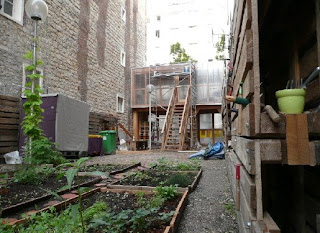Seed bombing, also known as "Seed Grenades" is a technique of introducing vegetation to arid soils or otherwise inhospitable terrains. A seed bomb is a compressed clod of soil containing live vegetation that may be thrown or dropped onto a terrain to be modified. The term "seed grenade" was first used by Liz Christy in 1973 when she started the "Green Guerillas". The first seed grenades were made from balloons filled with local wildflower seeds, water and fertilizer. The seed grenades were tossed over fences onto empty lots in New York City in order to make the neighborhoods look better. It was the start of the Guerrilla Gardening movement. (Wikipedia)
Tsuchi Dango {Earth Dumpling}) consist of mixing the seed for next season's crop with
clay,
compost, and sometimes
manure then formed into small balls. Much less seed is used than in conventional growing, resulting in fewer plants which are smaller but stronger with a higher yield.
Seed balls are very easy to make and are great for seeding waste areas in your yard. Use a combo of wild flower, mustards, radish seeds and wheat to create a haven for beneficial insects. ow the balls in winter in our next-door neighbor's yard. They had a long piece of bare ground adjacent to our garden that was full of weeds and bermuda grass *yuck*. This method has been successful in attracting many beneficial insects into the garden and has transformed the bare and unsightly spot into a beautiful wild garden.
Seed balls are a method for distributing seeds by encasing them in a mixture of clay and soil humus. Some native North American tribes used forms of seed balls. More recently natural farmer Masanobu Fukuoka has applied them, as have others inspired by his work.
Seed balls are simply scattered direct onto ground, and not planted. They could be useful for seeding dry, thin and compacted soils and for reclaiming derelict ground. This method takes a fraction of the time or cost of other methods to cover large areas and is also very applicable in small areas.
The clay and humus ball prevents the seeds from the drying out in the sun, getting eaten by predators like mice and birds, or from blowing away. When sufficient rain has permeated the clay and the seeds inside sprout they are protected within the ball that contains nutrients and beneficial soil microbes. Seed balls are particularly useful in dry and arid areas where rainfall is highly unpredictable. www.primalseeds.org
|  | STEP ONE: INGREDIENTS A. Dry terracotta clay, finely ground and sifted through a strainer to remove large chunks of clay. Amount: 1 1/4 cup |
|  | B. Dry organic compost. Amount: 3/4 cup C. 1/4 cup assorted seeds. Various wildflower & vegetable seeds can be used. |
|  | STEP TWO: Mix B & C together. (Seed mixed with dry compost.) |
|  | STEP THREE: Add A to B & C mix. Blend everything together well. Next, mist water onto the mixture while stirring. Spray just enough water to allow the mixture to stick/bind together. |
|  | STEP FOUR: Take a pinch of the finished mixture and roll (in the palm of your hand) into penny-sized round balls. |
|  | STEP FIVE: Put seed balls in the sun to dry completely for a day or two. |
|  | STEP SIX: Broadcast seed balls onto dirt area. Water or wait for rain to allow seeds to germinate. Makes approximately 30-40 balls |
|  | Seeds are starting to come up... ENJOY THE RESULTS!!! |
|
Suggested seeds to attract beneficial insects: Clover, alfalfa, alyssum, nasturtium, yarrow, carrot, dill, daikon, celery, radish, fennel, caraway, chervil, gypsophila, coriander, calendula, mustard, anise hyssop, phacelia, agastache, and amaranth. Note: Please be advised to check with your local nursery or agriculture agency to determine which beneficial, native plant species would best serve the habitat which you are trying to restore. Nonnative invader species that are proven voracious spreaders should never be used as a tool of ecological restoration.
Application rate: A minimum of ten seed balls per square metre, a higher density may be required to reclaim derelict land.
|

Seed Bombs by Kathryn Miller.
She designed these portable seed bombs for landscape re-vegetation purposes. They were thrown out into areas that were degraded, physically abused, or in need of vegetation. As a form of urban and suburban guerrilla activity, it was a small scale, non-sanctioned intervention in the landscape. The seed bombs were made available to museum visitors to take and throw somewhere they felt needed native plants, and in the process they assisted me with my project. The bombs contained seeds native to the area she was working in. She has made thousands, all hand packed. Sometimes she collects the seeds myself; sometimes buying them from special seed companies. Native seed are expensive so she often has to rely on writing grants to support this activity.
Seed bombing the Raytheon Plant, Santa Barbara, CA, 1992
Kathryn has targeted specific sites (bombing shown at top), and has also distributed the bombs to museum visitors. For more info, check out this past Seed Bomb exhibition at Pomona College. Her visuals show how man made disasters have impacted on ecosystems and environments throughout the world.
Lawns in the Desert
This series in collaboration with Michael Honer questions the idea of lawns which are entirely dependant on life support - imported water, chemical application, and endless manicuring.























